
FLORIDA
UNDER CIVIL STRIFE
THE CIVIL WAR AND RECONSTRUCTION IN FLORIDA
THE ROAD TO SUCCESSION FOR FLORIDA
Florida's plantation economy and Southern
population tied the state to the other Deep South
states on the slow road to succession. There would be opposition from some
Floridians, but with the rise in the North of the abolitionist movement and the
attempt to limit the westward march of slavery, Florida Democrats found themselves allied to
the states rights wing of the
Democratic Party. The Democrats of Florida
joined the Southern Rights Association.
By 1860 Florida was clearly in the category as a plantation state. The fastest growing area of the South was the fertile hills between the Apalachicola and Suwannee Rivers, a region best known as Middle Florida. With Florida's capitol city of Tallahassee in the center of this farming belt, the planters, allied by trade and marriage to successful professionals and merchants dominated the young state. Two out of every slaves worked in the cotton and tobacco fields of this area.
The Florida Whig Party which
contained many notable planters and businessmen opposed states-rights views,
but the slow decline of their party as a national institution in 1856, made it
difficult to recruit new supporters. They did form the American Party and came
within just 400 votes of defeating secessionist Democratic Governor
Madison Starke Perry. Four years
later, many of these ex-Whigs backed Constitutional Unionist Presidential
candidate John Bell.
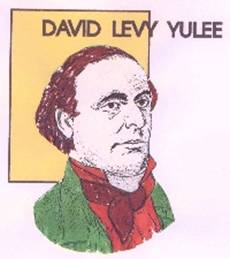
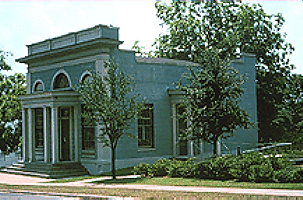

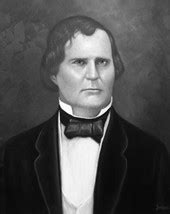 David Yulee - the Union Bank - Steven Mallory - Madison Perry
David Yulee - the Union Bank - Steven Mallory - Madison Perry
Florida's
two Senators, David L. Yulee and
Stephen R. Mallory were cautious about secession, but neither opposed
Perry's outspoken attack on Northern activities. The two major opponents of
secession were Key West Judge
William Marvin and former Governor
Richard Keith Call, who believed that
a state could not leave the Union. They could
not offset rising fear over Northern and abolitionist interference caused by
John Brown's raid at Harper's Ferry and the new Republican Party's platform
against new slave states.
At the
Southern Democratic Convention in June of 1859, the Florida
delegation dominated by planters was the only state to join South Carolina to threaten secession if the
Democrats don't openly oppose the antislavery forces. When the National
Democratic Convention selected Stephen Douglas of Illinois
and a moderate platform, Florida's
delegation backed a Southern Democratic candidate for President as the
solution.
While the majority of Floridians even in Middle Florida did not own slaves, few Florida small farmers had the time to engage in politics and most were not registered to vote. The heavily wooded hills of West Florida and the rivers of East Florida were dotted with independent farmers growing vegetables and fruits. Often distant from the nearest town and dependent on their own livestock, the small farmers were more concerned with the lack of transportation to markets than slavery.
In 1860 there were just seven hundred free blacks and freedmen residing in Florida. Most worked in the port towns of Jacksonville, Pensacola, and Key West, mainly in transportation and lumbering and fishing.
With the
Democrats running three candidates in 1860, Abraham Lincoln and the Republicans
won the White House and took control of dozens of Congressional seats held in
the North and Midwest by Democrats. South Carolina did not
wait to discover what the Republicans would do with Congress, but elected to
vote on secession and called for votes in the other slave states.

Governor Perry called a convention of
secession in January of 1861 in Tallahassee
to decide upon Florida's
future. The men who came represented mostly the rich, conservative order of the
state. Of the 69 delegates, 58 were slave owners. Perry was so certain the planters would win the vote, he ordered the seizure of the Federal arsenal at Chattahoochee and all Federal coastal forts. The poorly manned forts at Saint Augustine and Fernandina were easy to occupy, but Fort Taylor on Key West was guarded by Union ships. The Pensacola forts would be another issue.
Nevertheless,
those who opposed secession as unconstitutional were strong in East Florida and in some large port towns. They tried to
delay the vote stating that Florida should
wait for the decision of Alabama and Georgia.
Many planters wanted Florida to become the
second state to secede after South
Carolina. When the moderates strategy defeated, only
seven delegates voted to delay an early secession vote. Florida
voted to secede as soon as the news arrived from South Carolina.
FLORIDA'S MARCH TOWARD CIVIL WAR.
Florida became an independent state. By February
seven Southern states had seceded and elected to meet in Montgomery,
Alabama, to form the Confederate States of America.
They would not wait for Virginia to
secede nor would they wait for Lincoln's
inauguration to find out what Republican policies would be adopted.
Governor
Perry hoped the seizure of Federal arsenals in St.
Augustine, Fernandina, and Chattahoochee,
would provide the state militia with much-needed weapons. Others hoped the show of force across the Deep South would convince the North of the South's determination to protect its institutions.

Union
forces in Florida abandoned such undependable
locations at Fort
Barrancas and Fort McRee
in Pensacola Bay.On January 8, 1861, Florida militia showed up at midnight at the bridge to Fort Barrancas. Union sentries drove them away by firing shots. First Lt Adam Slemner had just 81 soldiers and he knew Fort Pickenson Santa Rosa Island was easier to defend. After spiking the cannon in those
two forts, the Union troops fled to Fort Pickens
on Santa Rosa Island. Alhough people in Charleston will laugh, Floridians like to argue that this was the first battle of the Civil War since it took place after the Confederacy was formed. Rebel groups from Alabama occupied the deserted Pensacola Navy Yard with its key dry-docks.
Yet, this shipyard is useless without access to the Gulf of Mexico, past Fort Pickens.
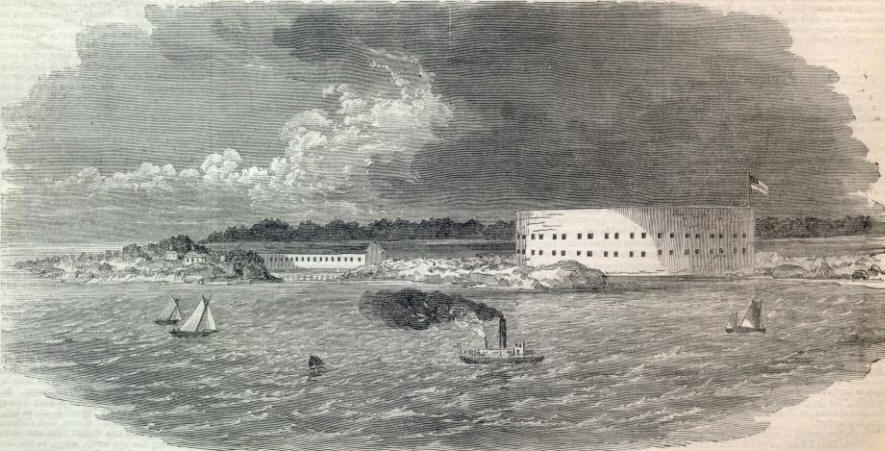
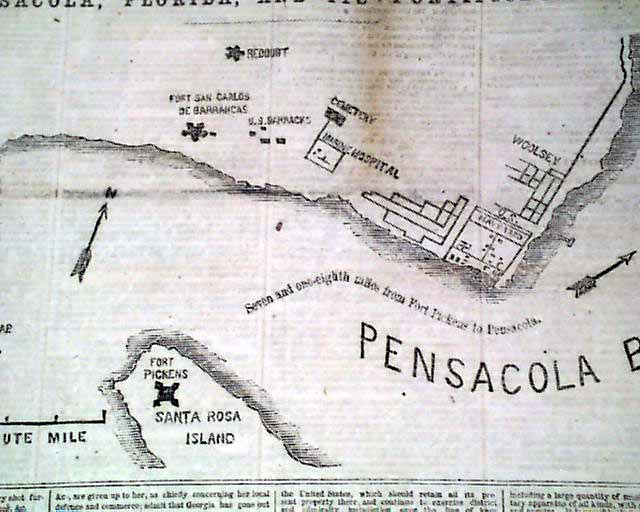
The South
waited the new President's actions and discovered that Lincoln
was determined to preserve the Union and to
maintain, if only for symbolic status, whatever Federal sites were left in the
South. The firing on Union supplies at Fort Sumter
in Charleston Harbor official placed the North and the
South in a Civil War. It was almost a relief to Florida leaders to know the fate of the
Confederacy. Virginia left the Union and as
richest and largest Confederate state got the capital switched to Richmond.
Florida was requested to recruit 5,000 soldiers.
In three months, Florida
had 6,772 volunteers. Ironically, the majority of the South's volunteers were
small farmers who owned no slaves.


THE UNION BLOCKADE OF FLORIDA
The immediate strategy of Lincoln's
Government and part of a greater strategy to straggle the Confederacy, known as
the "Anaconda Plan"
was the Union blockade. Florida's
huge coastline and extreme distance from the North made it impossible to
defend. Confederate Secretary of the
Navy Stephen Mallory, the only Floridian in the Rebel Cabinet, had to
reject attempts to protect Florida's
huge coastline. The South had no battleships and whatever coastal defenses
could be constructed, they had to be utilized to protect Savannah
and Charleston.
Union
gunboats surrounded state. Fort Taylor
in Key West, a
city that refused to join secession, supplied the Union units. Fort Pickens
was reinforced and despite heavy bombardment the Northern forces remained in Fort Pickens,
rendering Pensacola
worthless.
Florida
provided the South with two useful products: cattle from the interior south of Ocala and salt from
operations along the coast. In January, Union troops began a strategy that they
hope would eventually cut off these goods from northward shipment. In January
1862, Yankee troops occupied the port
of Cedar Key,
the Gulf terminus of the Yulee railroad. In March, a Federal fleet sailed down
the St. Johns and captured the port of Jacksonville.
Florida
sailors like Captain James McKay
were exempt from Confederate service because their ships smuggled Florida
cattle to Spanish Cuba, for much needed gold coins and supplies. Federal
gunboats tried to control Tampa Bay and Charlotte
Harbor. Blockades out of Key West never caught
McKay, but 232 smugglers were arrested. When they failed to find smugglers, the
gunboats attacked salt factories and sometimes innocent Cuban fishing camps.
Salt and cattle were so vital to the war effort that people in these industries
could avoid the Confederate draft.
When Union
forces began the attack on the Mississippi
Valley to split the Union in half, the
Confederacy realized that Florida
ranked second in the seceded states in cattle production. The grassy plains
around Gainesville
was the cattle center with as many as 10,000 cattle observed on Payne's
Prairie. As the threat of Union troops grew greater, herds were raised further
south to the Kississimmee
Valley.
Of all the
early Florida
cowboys, none was as notable as Jake Summerlin , a daring and reckless king of
prairie. He traded the peaceful life of a planter for the excitement of open
cattle grazing. Later, when the rail routes were destroyed, Summerlin allied
with McKay and A. F. Hendry in
smuggling cattle to Cuba.
Despite heavy Union gunboat operations, the smugglers utilized shallow draft
boats and a knowledge of the maze of islands in southwest Florida to allude capture.
By 1863
Summerlin was rich. Cattle in Havana
sold for $30 and only $3 to the Confederate government. Brigadier General John
Newton in Key West
sent a fleet of nine steamers and three schooners to Punta Rassa on the
Caloosahatchee to try to close off the cattle trade. Cuban doubloons could buy
a lot a weaponry for the Confederacy and Union did not want this Florida contribution to
the Confederate resistance to continue.


THE HOME FRONT IN FLORIDA
The Civil War was completely disruptive to the home front. Before the
end of the conflict some 15,000 Floridians out of a population of just 78,000
whites fought in the Civil War. Some 1,209 whites and 1,044 African-Americans
from Florida
served in the Union Army.
Despite exemptions on overseers,
government workers, salt makers, and cattlemen, Florida produced more than its share of
combat troops. 
Since much
of the war was miles north in Virginia and Tennessee, few Floridians could have advantage of leaves
to return to Florida.
Florida's leadership believed Florida was often
mistreated by policy which seemed to favor the larger states.
Women
administered many of the farms and stores with the men folk at war. As a state
of small farmers, the suffering caused by absentee workers was great. Ancestral
looms and crude tools replaced manufactured items.
Women
collected their old linen, dresses, tablecloths, draperies, and sheets to make
bandages for the wounded. Women wore Dixie
bonnets of plaited palmetto leaves and sandals made from corn shucks for heels.
Huge fund raisers helped build soldiers' lodges in Tallahassee
and Monticello.
Even the
household of the large plantations faced grave shortages caused by the
blockade, the destruction of the South's transportation system, and lack of
skilled laborers. Candles burned where gas lanterns were once lit. Homegrown
vegetables and pork headlined the diet, since quality foods were to the
military. Whites discovered the food items of slave menus. Coffee was made by
soaking cottonseed in water. Wallpaper was removed to make writing tablets.
Turpentine became a medical mouthwash and every town had a spider house to grow
cobwebs to cause wounds to clot more quickly.
Everyone
from planter to slave felt the impact of the Civil War. Despite the fears that
slaves would rebel, most slaves remained on the plantation, often assuming all
roles of field and barn management. While many slaves headed to Jacksonville to join the Union Army, others were hired by
the State of Florida
to rebuild roads and bridges.
THE INVASION OF FLORIDA
Florida was so far south it had its own Civil War.
The occupation of defensive Jacksonville in
March of 1862 opened the possibility of an invasion of Union gunboats down the St. Johns River to attack Palatka and the citrus region.
Yankee forces found many Northern sympathizers in this region of interstate
trade and business.
In
February of 1864, the expectant invasion of the Florida
interior began as General Truman
Seymore marched from Jacksonville toward Lake City,
the largest town between the Atlantic and the Suwannee
and the center of the railroad routes northward. Rebel forces from Georgia and Florida
volunteers descended upon the railroad depot town of Olustee, thirteen miles east of Lake City.

In the Battle of
Olustee, the largest battle in Florida's
Civil War, Confederate troops crushed the Union advance and sent the Federal
troops retreating to Jacksonville.
The center of the railroad remained open for the moment. There is one aspect of the Battle of Olustee that is not presented today. The Union commander left a Negro unit to protect the retreating forces and had no plan to rescue them. The Georgia regulars destroyed this unit without taking but three prisoners.

With this invasion halted, Northern
raiders elected to invade into cattle country to disrupt farms and cattle
herds. Northerner troops from the Gulf swept toward Marianna. A raid into the
Alachua prairies led to the Battle of Gainesville
where Union troops to stopped by Florida's
"War Eagle" cavalry leader, Colonel
John J. Dickison. While Florida
had a coastline too large to defend, the peninsula was long and narrow and
Dickison's forces could move in any direction to quickly defend the interior.
Union
troops decided if they could not destroy the railroad route to the north, they
would destroy it from the Gulf side. Federal forces marched northward up
Yulee's rail line from Cedar Key, but were halted in the Battle
of Cedar Key.
.
OPPOSITION IN FLORIDA TO THE WAR
The harsh realities of the war developed many divisions in the Florida political and
economic community. Small farmers resented those large planters who refused to
destroy their cotton fields and produce needed vegetables. The Union blockade skyrocketed prices as coffee went to $1 a
pound and pork to $60 per barrel. Many traders and smugglers made fortunes at
the expense of the desperation of others. Under the Confederate Impressment Act, the military could take food, clothing, and other vitals for use in the War. This meant that Florida, already a poor state with limited resources, was being stripped of essentials for daily survival.
As the war
in Tennessee
turned against the Confederacy, more Floridians were ordered into battle. General William Sherman's invasion into Georgia convinced Florida
leaders that the integrity of the Deep South
had been destroyed and the advantages of the North were offsetting the
performance of the South's great military leadership.
A fact that other Southern states usually ignore is the reality that Florida furnished more men in proportion to its population than any other Southern state. Florida's casualty rate was extremely high since most of the fighting was in Virginia and Tennessee, too distant from Florida for Florida troops to return to their home on even a one week leave and return. This led to high desertion rates by 1864. With one third of all white males over twenty in uniform by 1864, more and more Florida activities were run by women and African-Americans.
Yankee troops in the winter of 1864
decided to invade Tallahassee and Florida's prosperous
cotton kingdom. Florida's capital was but
twenty miles from the sea and vulnerable to attack as Florida units were fighting elsewhere. The
arrival of a large Federal force at St. Marks caused panic in Tallahassee,
but volunteers of wounded veterans and young cadets from Tallahassee
academies joined the Florida
defenses.

In the Battle of Natural Bridge this ragtag defensive
force halted Union advancement and drove them back to the Gulf. Florida, thus,
became the only Confederate capital east of the Mississippi to not fall to Union attack.
This last battle in Florida meant little as
Northern armies penetrated the South, separating Florida's resources from the Confederate
armies.


THE LAST DAYS OF CONFLICT IN FLORIDA
As early as the spring of 1865, there were reports that the South was
losing the Civil War, but in Florida,
where every Union invasion had been repelled there remained optimism. Governor
Milton was less optimistic for he received officials and human reports of the
destruction and misery of distant battlefields. As Florida's
declining forces returned to Tallahassee,
wounded and befallen of disease, Jefferson Davis was requested more soldiers
from Florida.
Milton argued that Florida's tiny pool of troops had already
were damaged by favoritism to larger Southern states.
When
Milton, his wife and son went to Marianna to view the destruction of farms
there, a group of Confederate soldiers, accused of being deserters for going
home to plant crops for their families, invaded Tallahassee in a vain attempt to kidnap the
Governor. The disconsolate Milton went to his
mansion Sylvania,
entered his office, and committed suicide.

Milton did
not hear about General Robert E. Lee's surrender at Appomattox eight days
later.Acting Governor Abram Allison,
already shocked by Milton's actions, did not at first believe that the Civil
War was over. Even upon acceptance of the truth, many planters believed they
had successfully defended their cause.
While
small groups of veterans refused to surrender and hid in the dense forests and
marshes of Panhandle Florida, most Floridians
recognized that slavery was at its end and so was a way of life that had
dominated the Florida
economy.
Jefferson
Davis and Stephen Mallory was captured en route to Florida, but Secretary of the Confederate Treasury Judah Benjamin escaped Florida
from a sailboat in Sarasota
Bay. It was rumored the
Confederate Treasury was buried near Newberry by an advance calvary unit sent
by President Davis. Others questioned whether they was enough money to even
count the cargo as a treasure.
RECONSTRUCTION IN FLORIDA
THE AFTERMATH OF WAR
The legacy of defeat would linger for generations in Florida. Of the state's 15,000 soldiers, one
third would fail to return home. Thousands more were wounded or injured in a
way one would not notice. They had been promised by U.S. Grant and the victorious Union
leaders that respect and honor would dominate the day, but it would be
politicians who would decide their situation, not their fellow uniformed
adversaries.
The small
farmers who constituted the Confederate Army tried to rebuilt their ragged
properties. The large toil of deaths of veterans just several years after the
close of the war are indications of the indirect effects of war injuries and
disease. Yet they were not totaled as war casualties nor were their entitled to
disabled benefits like their Union counterparts.
CARPETBAGGERS IN FLORIDA IN THE 1860s
Jacksonville, Cedar Key, Key West, and Pensacola soon filled with
Northern investors, government officials and opportunists. Former slaves, in
the confusion of the day, flocked to the coastal cities to seek employment.
Homeless families from Georgia
and Alabama entered Florida in hopes to locating deserted
homesteads.
Southerners
were sickened to see old estates sold to outside investors and large
plantations subdivided in land auctions. The assassination of Abraham Lincoln
put theRadical Republicans with
their abolitionist friends in charge of Reconstruction. Planters feared these
politicians more than the occupying Union troops who could prevent a race war.

Before the
Radicals had silenced Lincoln's successor, the
Unionist Democrat Andrew Johnson from Tennessee,
Floridians had quickly adopted Lincoln's plans
for a quick return to the Union. Moderate Judge
William
Marvin , headed the provisional government, reinstated most Southern
Democrats, and backed a new State Constitution that protected property rights.
In 1865,
the Democrats still controlled the Florida
Legislature and passed "Black Codes", limiting the voting rights of
African-Americans. Florida
elected conservative David S. Walker
Governor to protect the planter aristocracy.
The
Democratic return to power was short-lived. When the Radical Republicans had
fully taken control of Congress, they suspended all Southern Governments and
disfranchised all Confederate officers and elected officials, thus removing the
vote from the Southern Democratic leadership. Florida was placed under the Third Military District and the
Radicals began the registration of African -American voters into the Southern
Republican Party.

The new
Republican coalition of black and white voters elected the first Reconstruction
government, a group dominated by new businessmen and former slaves.
African-Americans held two dozen key jobs in Tallahassee and Dartmouth-educated Jonathan Gibbs
was elected the first Florida Commissioner for Education as well as serving as
Secretary of State. Florida's black population
was not as large percentagewise as South Carolina
and Mississippi,
but showed that years of slavery did not mean a lack of leadership skills.


REPUBLICAN AND BLACK POWER IN FLORIDA
The goal of the Radical Republicans was to assure that the Civil War
meant permanent change in the South and national politics. This would be
accomplished, it was thought, by the creation of a Southern Republican Party,
dominated by moderate whites and African-Americans; and by providing political
and economic power to the former slave.
The second Reconstruction Constitution, set up
by the Radicals, was designed to provide progressive change in Florida. It provided for
universal manhood suffrage, free public schools in every county, and a road
improvement plan. It placed huge powers in the hands of the Governor, who was a
Republican.
Military
rule in Florida
was supposed to terminate on July 4, 1868, but Governor Harrison Reed, fearing retaliation by conservative white forces
requested the continuation of Union forces. While Federal troops controlled the
large towns, rural Florida
soon erupted in racial violence and the rise of supremacy terrorist groups like
the Klu Klux Klan. A railroad
shipment of military arms for Reed's Tallahassee
troops was intercepted by southern whites and terrorism became common in rural
areas.
While Reed
returned Florida
to Congress and promoted the redevelopment of the state economy, the
mismanagement and corruption of inexperienced state leaders hurt Reed's goals.
Reed's attempts to increase the number of black voters met with violence.
CONSERVATIVE CARPETBAGGERS
Florida was one of five Southern states to have
two carpetbagger governors during Reconstruction. Yet Harrison Reed from Wisconsin and M. L. Sterns from Maine were neither militant abolitionists
nor abusive opportunists. Reed was a Republican newspaper editor sent by Lincoln in 1863 to Fernandina to administer the confiscation
of Rebel property in Florida.
He lost his status with the Radicals for opposing plans to prevent Confederate
officers from voting, but stayed in Florida
where he gained the backing of moderates.
HARRISON REED, CARPETBAGGER GOVERNOR
Reed won
the governorship in 1868 against a Democrat and a Radical Republican. He had
the backing of business leaders, moderate African-Americans, and the Freedmen's
Bureau, but angered both the Radicals and Democrats. The Radicals thought he
was becoming a Rebel and Southerners viewed him as a carpetbagger. The
inclusion of African-Americans into state and local government was viewed by
Southern Democrats as the end of political stability, but the Reconstruction
governments were ones of moderation and economic reform. Josiah T. Walls , a Union veteran from
Virginia, became Florida's
first African-American Congressman in 1870.
THE BLACK DILEMMA IN POST-WAR FLORIDA
Much of the Congressional legislature of Reconstruction was designed to
help the freedmen gain political and economic unity. The Freedmen's Bureau was certainly hated by Southern whites. Yet,
after two hundred years of slavery, old habits were hard to change.
African-Americans who fled to Florida's
cities for jobs found the carpetbaggers taking them or that they had no
qualifications for urban employment. Urban blacks had their own stores and
businesses with little room for employing others. As land distribution plans
failed, the rural African-American found only tenant farming, sharecropping,
and jobs on white estates for opportunities. Led by Josiah Walls (photo below),
African-Americans proposed moderate reforms in Congress for the South.

The Florida Bureau issued
three thousand homesteads to African-Americans, more than any other Southern
state. Its first state director Thomas
W. Osborn was respected by moderates for his massive food relief
program. Unfortunately, most of these farms were on poor soil and had been
deserted by white farmers.
The
Freedmen's Bureau's greatest problem was that it was also a political tool of
the Republican Party. While Osborn worked to develop job opportunities, his
aide Colonel John T. Sprague recruited
black voters into the Republican Party. This was a direct challenge to the
control of the South by the Southern Democratic Party.
The
greatest shortcoming of the Reconstruction plan was the reality that Florida would remain an
agricultural state, with the greatest land areas in the hands of Southern planters
and farmers, most of whom were Democrats. African-Americans could not easily
escape their economic dependence from their political enemies. Whenever the
Democrats regained local control, they passed new Black Codes to eliminate black voters with laws requiring poll
taxes and literacy tests and other political rules.
END OF RECONSTRUCTION IN FLORIDA
ThePresidential Election of 1876 marked
the end of Reconstruction. In a bizarre ending to a close election, Florida was one of three
Southern states which had two winners. Democrats claimed the election results
made Democrat Sam Tilden the winner, but Republican Governor M. L. Sterns rejected the vote in
several rural areas as rigged and ruled that Republican Rutherford B. Hayes had
the vote.


In Washington, the disputed
election was determined in a smoke-filled hotel room where the press never
found how Republican and Democratic committee members fully resolved the issue.
Rutherford B. Hayes was declared the winner of all three states (including
Florida) while Republican officials were announcing the removal of the last
Federal troops from the Florida.African-Americans felt they had be betrayed in
a game of power politics.
Reconstruction
was now terminated. The Southern Democrats could systematically eliminate the
Republican black vote, while trying to restore Florida to a conservative, agrarian Southern
state.





![]()






![]()
![]()

![]()


![]()






